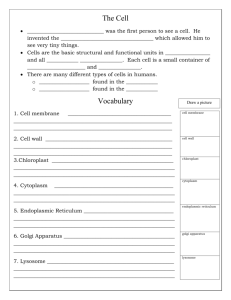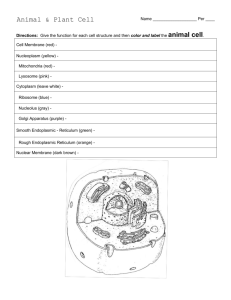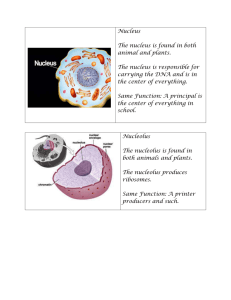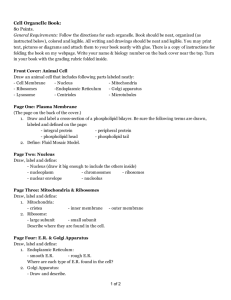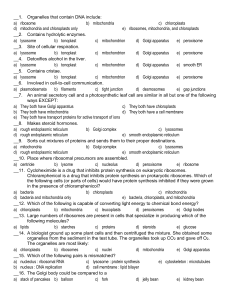cell structure packet
advertisement
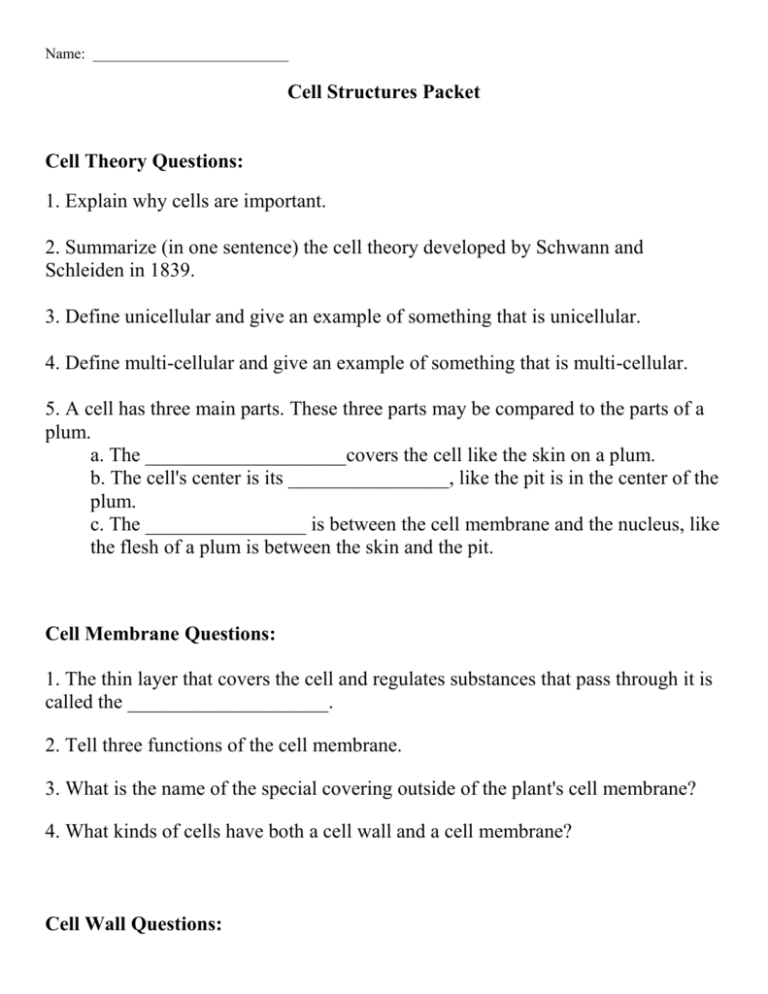
Name: __________________________ Cell Structures Packet Cell Theory Questions: 1. Explain why cells are important. 2. Summarize (in one sentence) the cell theory developed by Schwann and Schleiden in 1839. 3. Define unicellular and give an example of something that is unicellular. 4. Define multi-cellular and give an example of something that is multi-cellular. 5. A cell has three main parts. These three parts may be compared to the parts of a plum. a. The ____________________covers the cell like the skin on a plum. b. The cell's center is its ________________, like the pit is in the center of the plum. c. The ________________ is between the cell membrane and the nucleus, like the flesh of a plum is between the skin and the pit. Cell Membrane Questions: 1. The thin layer that covers the cell and regulates substances that pass through it is called the ____________________. 2. Tell three functions of the cell membrane. 3. What is the name of the special covering outside of the plant's cell membrane? 4. What kinds of cells have both a cell wall and a cell membrane? Cell Wall Questions: 1. Only __________ cells have cell walls. Animal cells do not have cell walls. 2. Cell walls are the __________ layer of plant cells. 3. The cell wall provides __________ (so that the plant can grow tall) and protection for the plant cell. 4. The cell wall is what makes plants __________. 5. List three important things that can pass through the cell wall of a plant. 6. Besides a plant, what other kind of cell has a cell wall? Cytoplasm Questions: 1. Define cytoplasm. 2. What is the difference between a prokaryotic and eukaryotic cell? 3. What can you find inside the cytoplasm of all cells? 4. List the names of at least 4 organelles that are found in the cytoplasm of eukaryotic cells. Ribosome Questions: 1. What kind of organelle is found in every kind of cell? 2. What do ribosomes do? 3. Where are ribosomes found in a cell? 4. What do the ribosomes do that are floating in the cell's cytoplasm? 5. What do the ribosomes do that are attached to the endoplasmic reticulum? Mitochondria Questions: 1. Why are mitochondria called the powerhouse of the cell? 2. Why are mitochondria like our digestive system? 3. How do mitochondria produce energy? 4. Name one interesting fact that scientists recently discovered about mitochondria. Endoplasmic Reticulum Questions: 1. The endoplasmic reticulum (ER) is made up of a network of __________ and sacs. 2. There are two types of ER: __________ ER and _________ ER. 3. Why is the rough ER important to a cell? 4. What other organelles does the ER work with in the cell? 5. What are three important functions of the smooth ER? Golgi Apparatus (Golgi Complex) Questions: 1. What are four important functions that are done by the Golgi complex? 2. What is the relationship between the Golgi complex and the endoplasmic reticulum? 3. What organelle does the Golgi apparatus form? 4. The Golgi complex in plants may also create complex __________. Vacuole Questions: 1. I compared vacuoles to backpacks. Write a simile of your own that describes the function of a vacuole. 2. What are three things that are stored in a vacuole? 3. Explain how vacuoles are related to plant structure. Nucleus Questions: 1. Explain why I can compare a nucleus to a brain. 2. What kinds of things are inside of a nucleus? 3. What is DNA responsible for? Chloroplast Questions: 1. Why are chloroplasts important? 2. During photosynthesis, ____________________ and __________ are joined together to make sugar and oxygen. 3. __________ cells do not have chloroplasts. Therefore, they cannot make their own food. Lysosome Questions: 1. The overall purpose of a lysosome in a cell is to ___________ things. 2. Describe how a lysosome is created. 3. Describe the four functions of a lysosome. Cytoskeleton Question: 1. What three functions does the cytoskeleton have? Cells, Tissues, Organs, Systems Questions: 1. In a one-celled living thing, one cell does __________. 2. A group of cells that work together to do a special job make up a__________. 3. The cells in the tissue are all __________ and do the same work. 4. Groups of tissues that do special jobs make up __________. Your brain is an organ. 5. A group of organs that work together make up a __________. For example, you have a nervous system. Your brain, nerves, eyes and ears are some organs in your nervous system.
